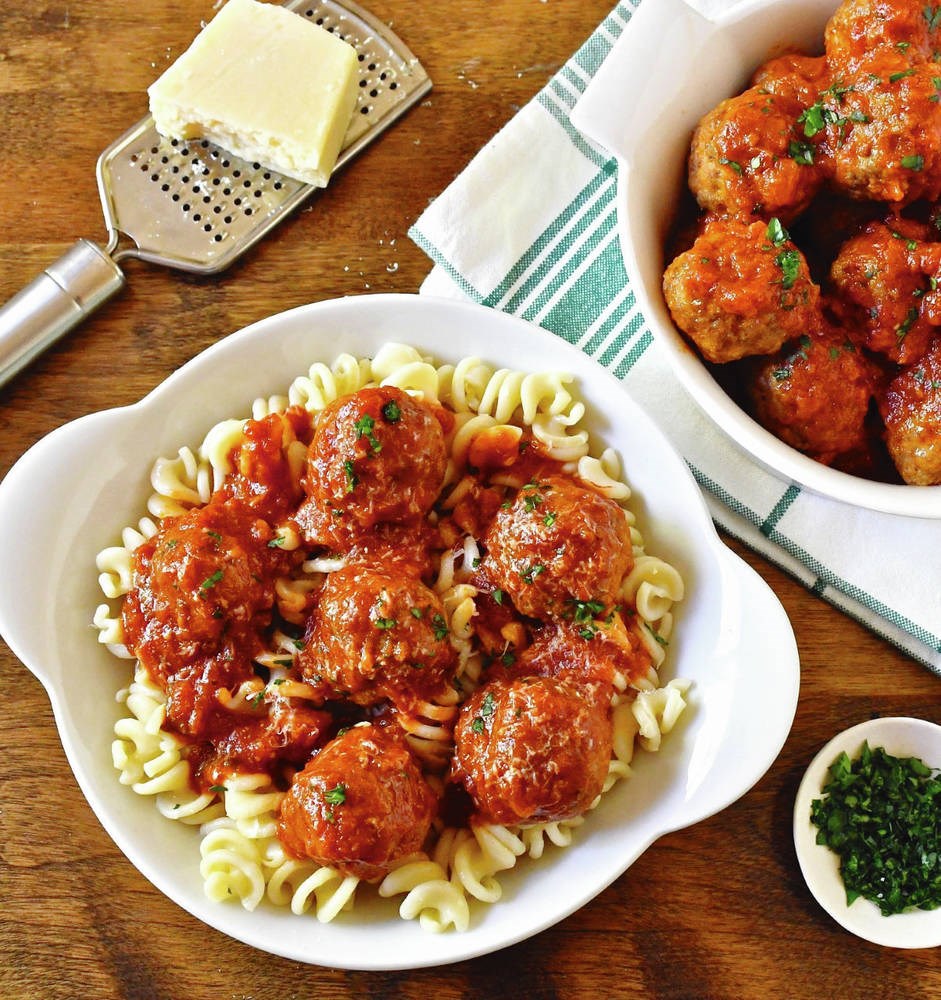You could call it meatball therapy, but I enjoy everything about making them. Choosing what type of meatball to make, rolling them up, cooking them, deciding how I’ll sauce them and, of course, eating them, all make me feel good
I was recently in need of that kind of culinary relief and decided to make Italian-style meatballs rich with ricotta cheese. Ricotta is sometimes referred to as “whey” cheese. Whey, which contains milk solids and a protein called albumin, is the liquid left over after cheese curds are pressed to make firmer styles of cheese.
Ricotta is an Italian word that means “re-cooked.” It’s a logical name for the cheese, because to make ricotta, that leftover whey is cooked and processed with other ingredients, such as an acid. During the process, it thickens into a fresh style of cheese that’s lighter and moister than cream cheese, with a slightly grainy texture.
It’s quite a lovely product. When mixed into the ground-beef mixture I used for my meatballs, it added a subtle richness. It, and the freshly grated Parmesan cheese I also added, made the meatballs appealingly tender when cooked.
I flavoured the meatballs with such things as oregano and garlic, and after roasting them, simmered them in tomatoey marinara sauce. As noted in the meatball recipe, you can use store-bought marinara sauce, or make your own by using my recipe below.
The meatball recipe yields four servings of six meatballs each. If that’s too many for you, any leftover meatballs will freeze well, to thaw, reheat and enjoy at another time.
You can serve the meatballs on pasta, gnocchi, polenta or even risotto. The meatballs could also be used to make saucy meatball sandwiches, by stuffing them into buns with some baby arugula or shredded lettuce.
Ricotta Meatballs with Marinara Sauce
Tender, ricotta-rich meatballs, roasted and simmered in a tomatoey sauce. Serve the meatballs on pasta, gnocchi, polenta or risotto. Or use them to make meatball sandwiches.
Preparation time: 25 minutes
Cooking time: about 40 minutes
Makes: four (six meatballs each) servings
1 lb. lean ground beef
3/4 cup ricotta cheese
1/3 cup freshly grated Parmesan cheese, plus some for the table
1 large egg
1/2 cup dried breadcrumbs
1 medium garlic clove, minced
1 tsp dried oregano
1 tsp salt
1/2 tsp freshly ground black pepper, or to taste
2 cups (500 mL) store-bought or homemade marinara sauce (see Note and recipe below)
1/3 cup water
• chopped fresh parsley, to taste (optional)
Line a baking sheet with parchment paper, unless it’s non-stick. Place the beef, ricotta, 1/3 cup Parmesan cheese, egg, breadcrumbs, garlic, oregano, salt and pepper in a bowl and gently mix until well combined.
Preheat oven to 400 F. Moisten your hands lightly with cold water. Now roll the meat mixture into 24 about 1 1/2-inch balls, setting them on the baking sheet as you go along. Roast the meatballs 20 minutes, or until cooked through. Remove from the oven and set aside for a moment.
Pour the marinara sauce and water into a wide skillet or pot (mine was 10 inches wide). Set over medium heat and bring to simmer. Set the meatballs in the marinara sauce, swirling the pan to coat them with it.
Return to a simmer, then simmer meatballs in the sauce 10 to 15 minutes, turning them occasionally. Serve portions of the meatballs sprinkled with additional grated Parmesan cheese and chopped fresh parsley, if using.
Note: You can make your own marinara sauce by using the recipe below. If you’re using store-bought marinara sauce, you’ll find jars of it for sale in the pasta-sauce aisle of grocery stores and at Italian-style food stores. The fantastic type I used in this recipe was made by Victoria’s Zambri’s restaurant (zambris.ca). You can buy jars of it direct from the restaurant and at some local food stores. I bought it at the Old Farm Market in Oak Bay.
Marinara Sauce
This is my method for making flavourful, rich-red marinara sauce. It makes more than the two cups you’ll need for the meatballs, but you can save the rest for another time. Beyond meatballs and pasta, you could also use the sauce for such things as pizza and chicken Parmigiana.
Preparation time: 10 minutes
Cooking time: About 40 minutes
Makes: About seven cups
2 (28-oz/798 mL) canned whole Italian San Marzano plum (roma) tomatoes (see Note)
1/4 cup extra virgin olive oil
1 large garlic clove, half and thinly sliced
1/2 cup finely chopped onion
1 tsp dried oregano
• pinch granulated sugar
8 fresh basil leaves, torn
• salt and freshly ground black pepper, to taste
Place the tomatoes and their juices in a bowl. Use your hands to squash the tomatoes and break them into chunks.
Heat the oil in a medium-sized, heavy-bottomed pot set over medium heat. Add the garlic and onion and cook a few minutes, until both are fragrant and very light golden.
Add the squashed tomatoes, oregano and sugar. Bring to a gentle simmer (small bubbles should just break on the surface), adjusting the heat as needed to maintain that gentle simmer.
Loosely cover the pot and simmer sauce 30 minutes. (Don’t completely cover the pot, as the steam rising from the sauce must be allowed to escape.) Now stir the basil into the sauce and cook 1 minute more.
Purée the sauce in a blender or food processor, or right in the pot with an immersion blender. Taste the sauce, and season with salt and pepper, as needed.
The sauce is now ready to use for the meatballs. Cool the leftover sauce and save for another time. Refrigerate for up to 3 days, or put the sauce in suitably sized containers and freeze.
Note: Deep red, Italian San Marzano plum (roma) tomatoes are sold in the canned-tomato aisle of most supermarkets and Italian-style food stores.
Eric Akis is the author of eight cookbooks. His columns appear in the Life section Wednesday and Sunday.



